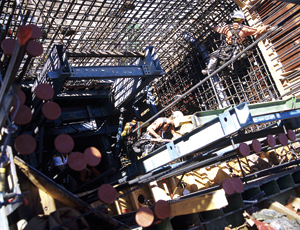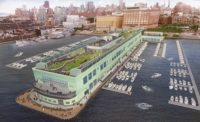A funding delay, a cableway collapse and a death: Construction of the Hoover Dam Bypass is a challenge-filled saga that rivals the building of the historic dam itself. But the light at the end of the canyon is beckoning. North America’s longest single-arch concrete crossing, at 1,960 ft, now soars 88 ft over the Colorado River and is scheduled to open to traffic in November 2010. It will carry vehicles 1,500 ft downstream from Hoover Dam, spanning the Black Canyon at the borders of Nevada and Arizona and answering a need that dates back to the 1960s.
In August, construction reached a major milestone as crews connected the bridge’s center arch and removed supporting cables. The $240-million project is managed by the Federal Highway Administration’s Central Lands Highway Division, which took over after the U.S. Bureau of Reclamation withdrew in 1993. The project then was placed on hold in 1995 but resumed two years later. It was the first delay, but not the last.
More than 17,000 vehicles a day travel over the Depression-era Hoover Dam’s two-lane roadway. Traffic volume is expected to increase 50% over the next 20 years for this section of U.S. Highway 93, which is part of the CANAMEX Corridor—a high-priority trade route that is part of the North American Free Trade Agreement between the U.S., Mexico and Canada. It also is identified as a high-priority corridor in the National Highway System Designation Act of 1995. After Sept. 11, 2001, more than 2,000 trucks a day have been diverted 23 miles away from the dam, costing consumers some $30 million annually in added fuel and delays, reports the Nevada Motor Transport Association, a Sparks, Nev.-based trucking group.
“Right now, our guys cannot go over the dam. They have to go through Laughlin instead,” says Paul Enos, NMTA chief executive officer. “The bridge is important for more efficiently moving commerce and goods throughout the West.”
When opened, the bridge and new highway alignment will transform U.S. 93 into a major corridor and a viable trucking alternative to the Interstate. “I think it is going to have a huge impact,” says Ray Bacon, executive director of the Nevada Manufacturers Association, a Carson City-based industry trade group.
It will also be an iconic, elegant structure composed of reinforcing steel struts between twin concrete arch ribs. The struts add ductility to the lateral framing system for extreme seismic loads. The bridge’s concrete deck and steel box girders are supported on 440 precast-concrete spandrel columns, each averaging 10 ft in length and stacked up to 280 ft high from the canyon floor. The striking, 277-ft-deep twin-rib arch consists of 104 segments, each about 25 ft long.
The joint venture team of Obayashi Corp., San Francisco, and PSM Construction USA Inc., a Brisbane, Calif.-based unit of PS Mitsubishi Construction Co. Ltd., won the $114-million contract to build the bridge in October 2004, in part because it proposed to use an unusual cableway system to string segments into place, like garments on a clothesline. The team leased the system from American Bridge Co., Coroapolis, Pa., which refurbished it for the project. Design, fabrication, assembly and testing took seven months. The system, built in 1964, was used on West Virginia’s New River Gorge Bridge in the 1970s.
Obayashi/PSM’s batch plant and precast yard is located 11 miles from the crossing’s south side and 30 miles southeast of Las Vegas, in Nevada. Bridge segments were individually loaded onto a tractor-trailer and driven to the jobsite, where two 330-ft-high lattice-framed cableway towers support 2,500-ft-long, 3-in.-dia. cableways strung across the canyon. The towers are secured by concrete foundations and cable staybacks in the cliffs. To place a segment, crews positioned a pair of 13.5-ton trolley-and-load-block assemblies carrying a custom-designed frame—a double steel channel connected to a W-flange—above. After attaching the segment, the frame lifted it into place.
“The cable drapes across the canyon, so you have to hoist it 100 feet into the air from the canyon edge,” says Obayashi/PSM JV project manager Jeff St. John. The trolley was controlled electronically from a cab 100 ft behind the towers. Workers communicated with the high-line operator by radio to position each segment into place.
“From the time they hoist a segment and lower it into place, it takes the better part of an hour,” St. John says. As the bridge’s arch took shape, cable stays were removed. The contractor adjusted slack in the cables to change...























Post a comment to this article
Report Abusive Comment